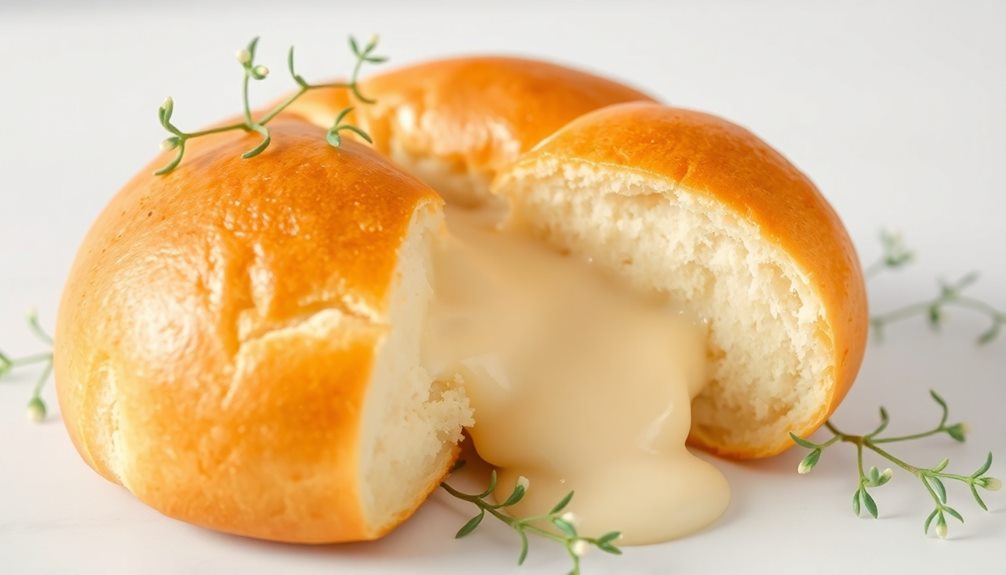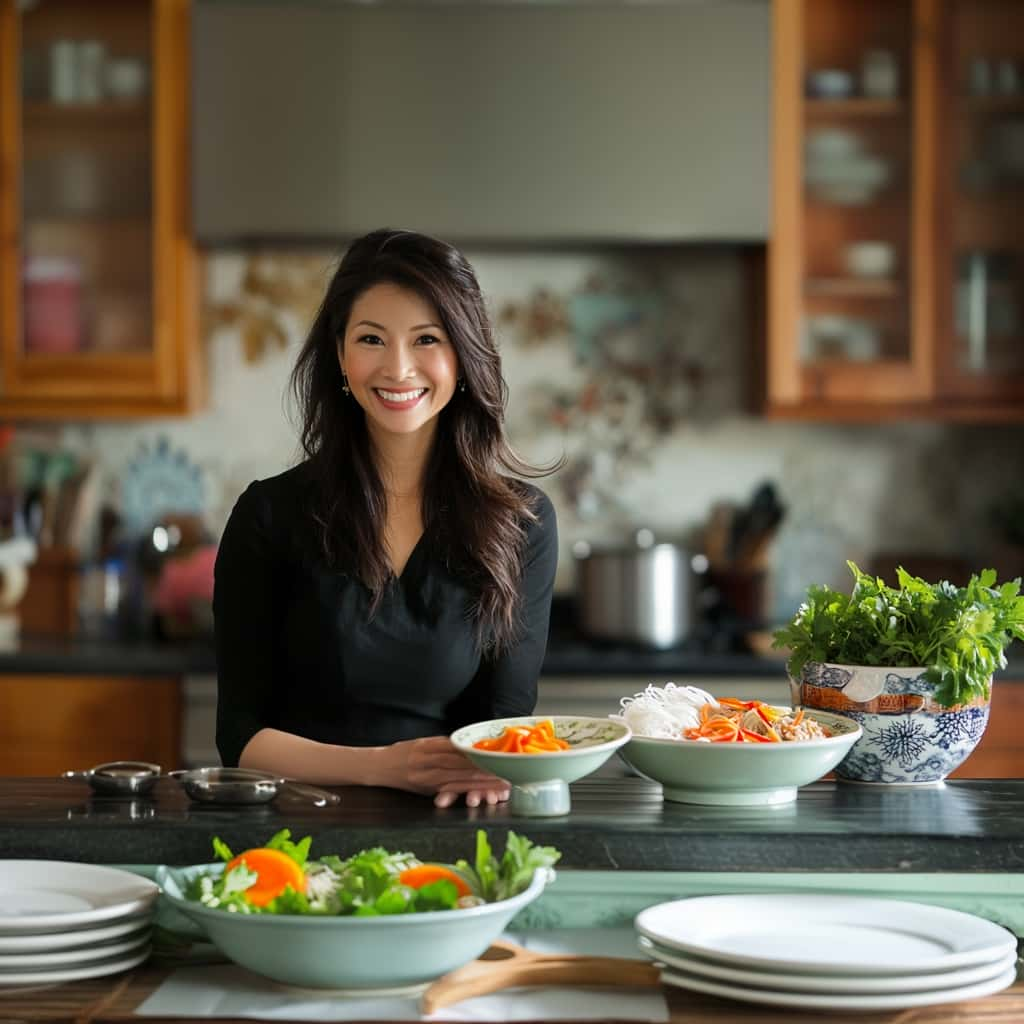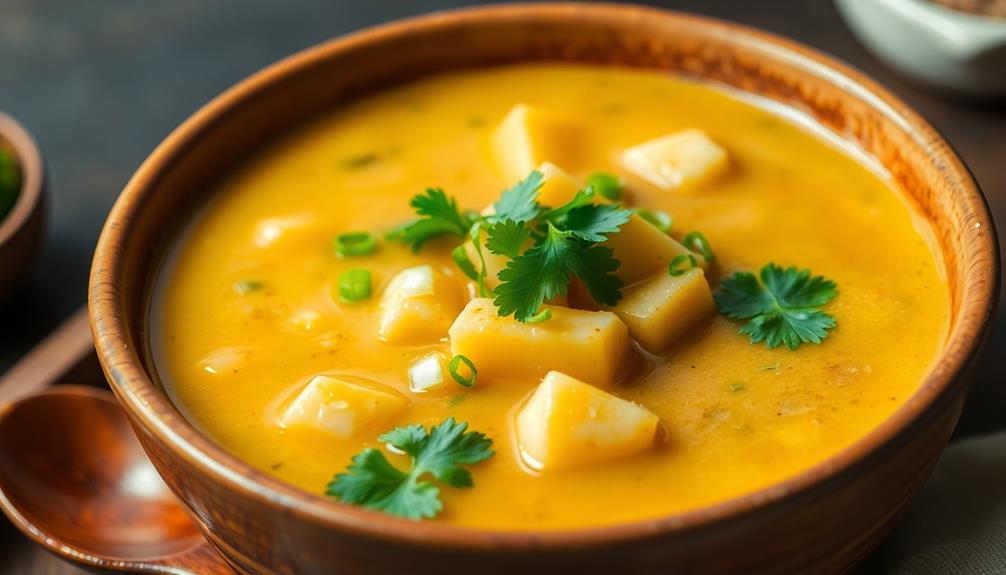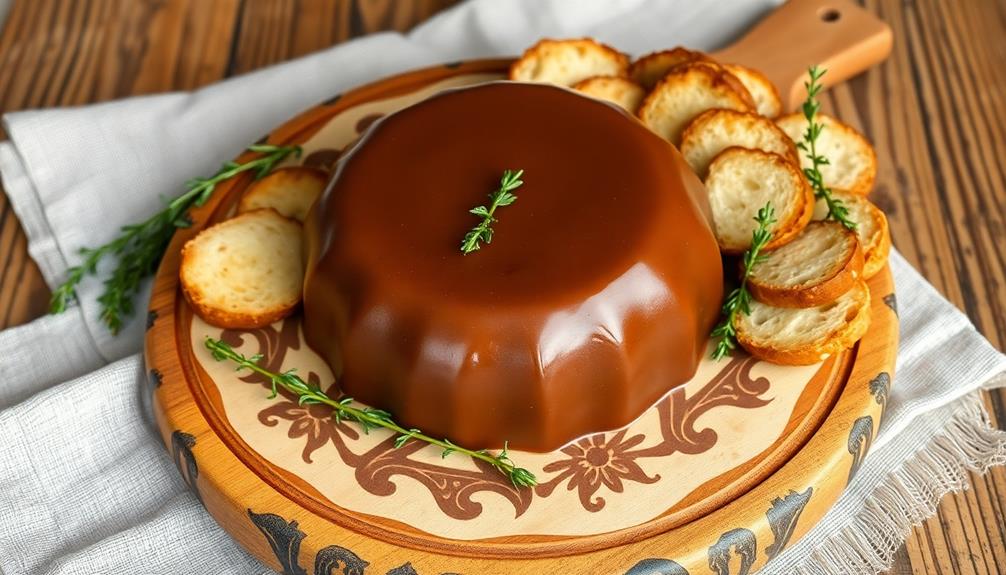Vietnamese rice cakes, especially Bánh Chưng and Bánh Tét, are delightful symbols of tradition and togetherness. Bánh Chưng is square-shaped, representing the Earth, while Bánh Tét is cylindrical, symbolizing the sky. Both are made from sticky rice, mung beans, and pork, wrapped in banana leaves. These tasty treats are often made during the Lunar New Year, bringing families together to honor ancestors. The cooking process involves soaking the rice, preparing the filling, and steaming these wonderful cakes for a few hours. Each bite connects you to the rich history and flavors of Vietnam, and there's so much more to uncover!
Key Takeaways
- Vietnamese rice cakes, including Bánh Chưng and Bánh Tết, are made from glutinous rice, symbolizing cultural heritage during Lunar New Year celebrations.
- Bánh Chưng is square-shaped, representing the Earth, filled with mung beans and pork, and traditionally prepared for Tết.
- Bánh Tết is cylindrical, symbolizing the sky, and can be sweet or savory, popular in southern Vietnam during Tết festivities.
- The preparation of rice cakes involves soaking, steaming, and wrapping in banana leaves, emphasizing family gatherings and communal cooking.
- Nutritionally, these rice cakes provide carbohydrates, protein, and dietary fiber, with variations offering different flavors and textures.
History
Vietnamese rice cakes have a rich and fascinating history that dates back thousands of years. Imagine a time when people in Vietnam first discovered how to make delicious cakes from rice! These cakes, called bánh, are more than just tasty treats; they've become a big part of Vietnamese culture and traditions.
You'll find that each type of rice cake tells a story. For example, bánh chưng is shaped like a square and symbolizes the earth, while bánh tét is round, representing the sky. These cakes are often made during special celebrations, like the Lunar New Year, when families come together to honor their ancestors and share love.
As you explore their history, you'll see how these rice cakes have been enjoyed through generations. They showcase the creativity and resourcefulness of the Vietnamese people. Each bite carries a piece of history, connecting you to the past.
Cooking Steps
Preparing Vietnamese rice cakes involves a few key steps that will ensure you achieve that perfect texture and flavor.
First, gather your ingredients: glutinous rice, mung beans, pork, and banana leaves. You'll want to soak the rice and mung beans overnight to make them soft and ready for cooking.
Next, start by steaming the mung beans until they're mashed and creamy. While that's cooking, prepare your pork by marinating it with some salt and pepper.
Once everything's ready, it's time to assemble! Lay out the banana leaves, and add a layer of rice, followed by a layer of mung beans, and then your marinated pork. Top it off with more rice.
Now, fold the banana leaves carefully, creating a neat package. Place them in a large pot of boiling water and steam for about 6 hours. Yes, it takes time, but patience is key!
When they're done, let them cool a bit before unwrapping. You'll feel so proud as you reveal your delicious Vietnamese rice cakes, ready to share with family and friends.
Enjoy every bite; you've earned it!
Step 1. Soak Glutinous Rice Overnight
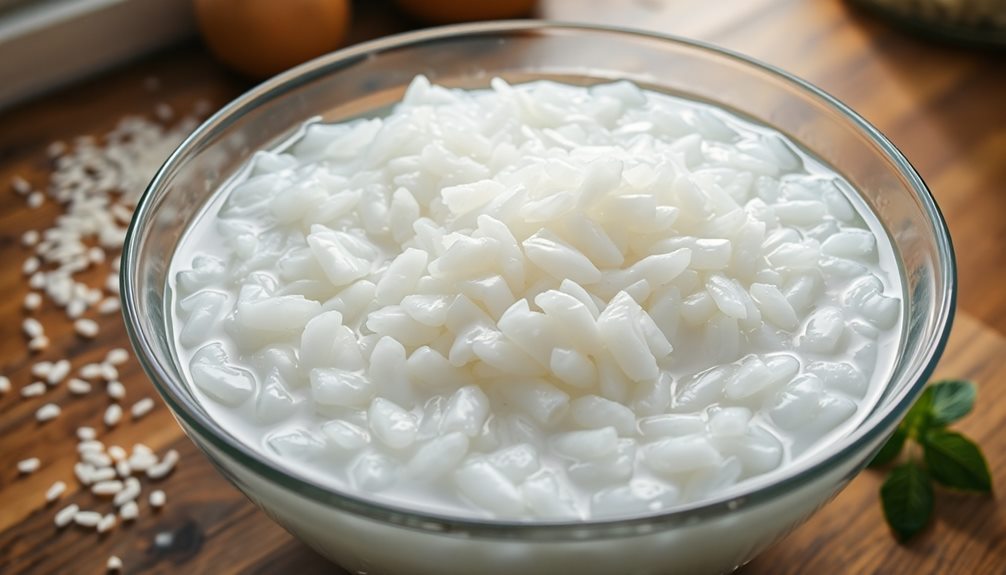
Soaking glutinous rice overnight is essential for achieving the perfect texture in your rice cakes. When you soak the rice, it absorbs water, which helps it soften and become sticky. This stickiness is what makes your rice cakes chewy and delicious!
To start, grab a bowl and measure out the amount of glutinous rice you need. Rinse it under cold water a few times to remove any dirt or excess starch. Once it's clean, fill the bowl with water, making sure the rice is fully submerged.
Now, cover the bowl with a lid or plastic wrap, and let it sit overnight. This isn't just a waiting game; it's a crucial step! While you sleep, the rice will soak up that water, getting ready for the next steps.
You'll wake up to perfectly plump grains that are ready to be transformed into mouthwatering rice cakes.
Step 2. Prepare the Filling Mixture

To create a delicious filling for your rice cakes, start by gathering your ingredients. You'll need mung beans, fatty pork, and seasonings like salt and pepper.
First, rinse the mung beans and soak them in water for at least four hours, or overnight if you want them super soft. Once they're ready, steam the beans until they're tender, then mash them into a smooth paste.
Next, chop up the fatty pork into small pieces. Heat a pan over medium heat and sauté the pork until it's cooked through and slightly golden.
Add the mashed mung beans to the pan, mixing them well with the pork. Season the mixture with salt and pepper to taste. You can also add a little sugar for a hint of sweetness if you like!
Stir everything together for about five minutes until it's nicely combined. Once your filling is ready, let it cool for a bit.
This delicious mixture will add a wonderful flavor to your rice cakes. Remember, the tastier the filling, the better your final dish will be! Now you're one step closer to making your amazing Vietnamese rice cakes!
Step 3. Wrap in Banana Leaves
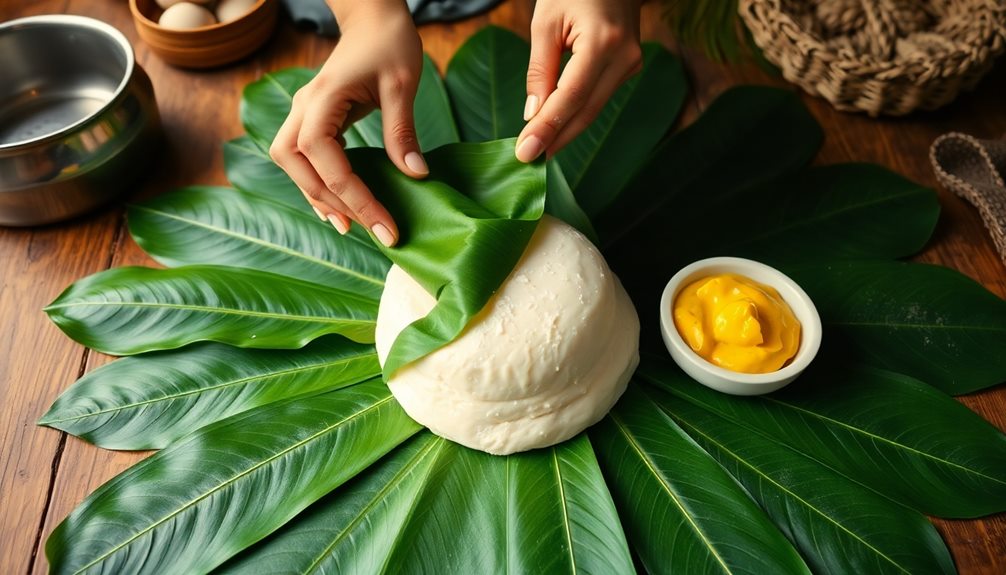
Once your filling has cooled, you're ready to wrap it in banana leaves. First, grab a large banana leaf and cut it into rectangles, about 10 inches by 12 inches. Make sure the leaf is clean and smooth, as this will help keep your rice cakes neat!
Next, take a piece of banana leaf, and lay it shiny side up on your work surface.
Now, place a scoop of your filling in the middle of the leaf. Then, take a scoop of your rice mixture and spread it on top of the filling. It's like making a cozy little blanket for your yummy treat!
Fold the sides of the banana leaf over the filling, then fold the top and bottom to seal it all in. Be gentle but firm, so nothing spills out. You can use kitchen twine to tie the package tightly, making sure it stays together during cooking.
Repeat this process until you've wrapped all your rice cakes. It's a fun activity, and soon you'll have a beautiful collection of wrapped cakes, ready for cooking!
Enjoy this special moment of creating something delicious.
Step 4. Steam for Two Hours
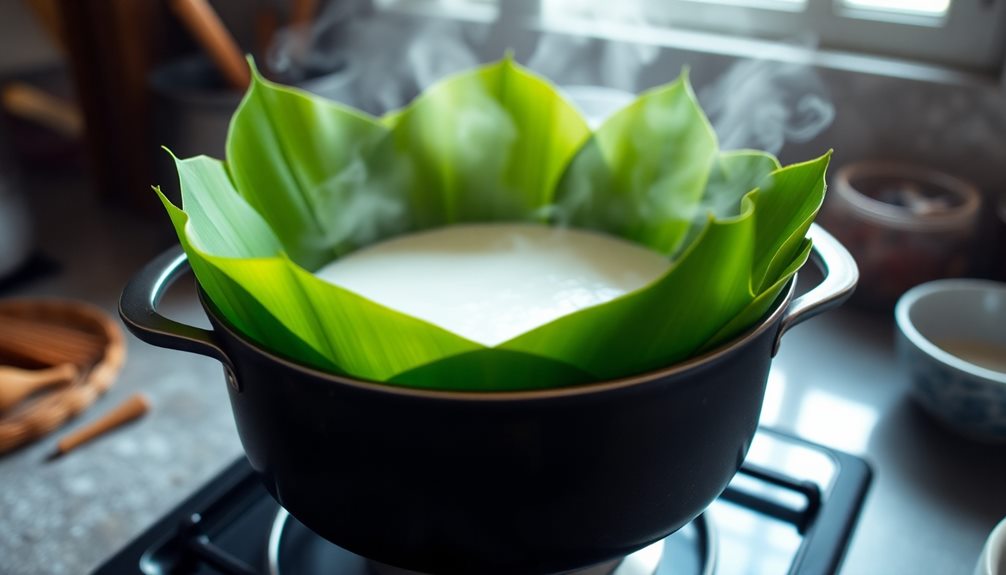
After you've wrapped all your rice cakes, it's time to steam them for two hours. This step is super important because it makes the rice cakes cook evenly and become deliciously soft!
First, grab a large pot and fill it with water, making sure you have enough so it won't run dry. Place a steaming rack or a plate inside the pot to keep the rice cakes above the water.
Next, arrange your wrapped rice cakes on the rack or plate. Try not to overcrowd them, as they need some space to steam properly. Once everything's set, cover the pot with a lid.
Now, turn on the heat and let the magic happen! As the water heats up, you'll start to see steam rising. The smell will fill your kitchen, and you might find it hard to wait!
Set a timer for two hours and relax. You can dance around, read a book, or even help in the kitchen with another task. Just keep an ear out, so you know when it's time to take them off the heat.
Soon, you'll have perfectly steamed rice cakes ready for the next step!
Step 5. Cool and Slice Cakes
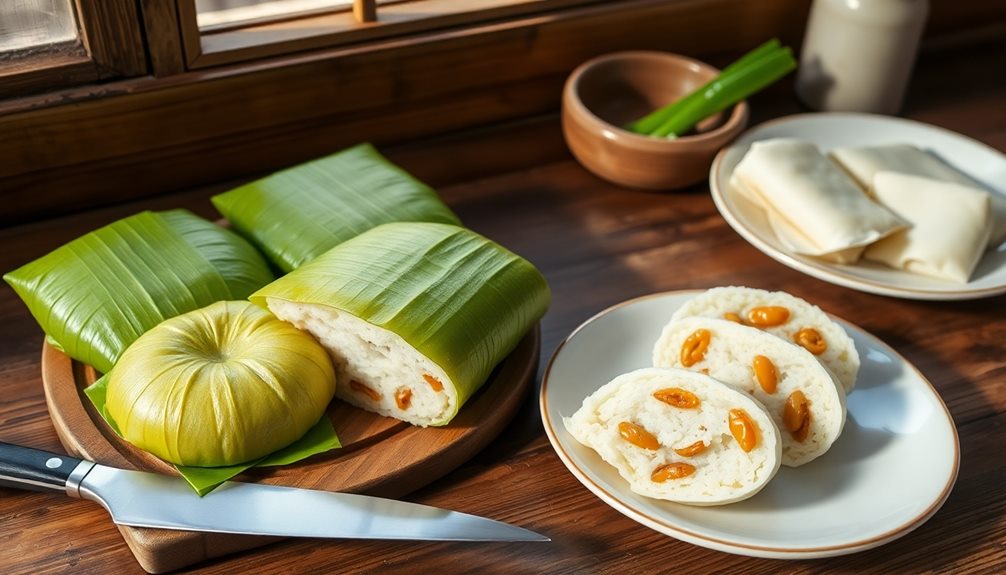
Typically, you'll want to let the steamed rice cakes cool for about 15 to 20 minutes before slicing them. This cooling time helps the cakes firm up, making them easier to cut without falling apart. You can let them cool right in the steamer or transfer them to a cutting board if you prefer.
Once they've cooled, grab a sharp knife. It's important to use a knife that's smooth and clean, so you get nice, even slices.
Start by cutting the cakes into squares or rectangles, depending on how you like them. You can make each piece as big or small as you want—it's totally up to you!
As you slice, you might notice the lovely layers and colors inside the cakes. This is where all the hard work pays off!
After slicing, you can arrange the pieces on a plate. They look so beautiful and inviting, you'll want to share them with family and friends.
Enjoy your delicious rice cakes, and don't forget to savor each bite! Whether it's a special occasion or just a tasty treat, these cakes are sure to bring smiles to everyone who tries them.
Final Thoughts
How do you feel about the versatility and cultural significance of Vietnamese rice cakes? These delightful treats aren't just tasty; they represent a rich history and tradition.
From Bánh Chưng at Tet to Bánh Tét during special occasions, rice cakes connect generations and cultures. You can see how each cake tells a story, bringing families together for celebrations and gatherings.
When you try making or tasting these rice cakes, you're not just enjoying a snack; you're experiencing a piece of Vietnamese culture!
The flavors and textures can vary greatly, making each cake unique. Whether you prefer the savory or sweet versions, there's a rice cake for everyone.
Frequently Asked Questions
What Are the Main Ingredients in Vietnamese Rice Cakes?
When you make Vietnamese rice cakes, you'll need glutinous rice, water, salt, and optional fillings like mung beans or pork. These ingredients combine to create delicious treats enjoyed during special occasions and celebrations.
Can I Substitute Ingredients in Bánh ChưNg or Bánh Tét Recipes?
Yes, you can substitute ingredients in bánh chưng or bánh tét recipes. Experiment with different grains or fillings, but keep the texture and flavor in mind to maintain the dish's authenticity. Enjoy your culinary creativity!
How Should I Store Leftover Rice Cakes?
To store leftover rice cakes, wrap them tightly in plastic wrap or place them in an airtight container. Refrigerate for up to a week, or freeze them for longer preservation. Reheat before serving.
Are There Gluten-Free Options for Making Rice Cakes?
Yes, there are gluten-free options for making rice cakes! You can use glutinous rice flour or regular rice flour combined with water and other ingredients. Just ensure all your ingredients are certified gluten-free for safety.
What Are the Cultural Significance of Bánh ChưNg and Bánh Tét?
Bánh chưng and bánh tét symbolize Vietnam's agricultural heritage and familial bonds. You'll find them celebrated during Tet, honoring ancestors and promoting unity, as their unique shapes reflect the earth and sky, embodying cultural significance.

